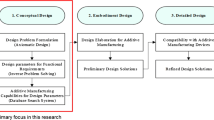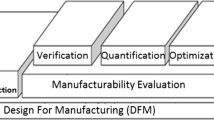Abstract
Innovative design in the development of new product and process has become the core value in most business establishments. These innovative designs are often associated with the long-established trade-off compromises or conflicting performance parameters where speed and reliability or quality and cost are readily acknowledged. The rate of change in technology and the commercial environment suggests that the opportunity for innovative design is accelerating and systematic support for innovation process is needed. This study combines the Russian theory of inventive problem solving (TRIZ) and the analytical hierarchy process (AHP) for designing the automated manufacturing systems. This study applied the contradiction matrix table, 40 innovative principles, and 39 engineering parameters to compromise the trade-off between design contradictions and engineering parameters. The design engineers can acquire more feasible solutions and inspiration through the proposed approach. However, due to vagueness and uncertainty in the decision maker’s judgment, an AHP is employed as a decision support tool that can adequately represent qualitative and subjective assessments under the multiple criteria decision making environment. Moreover, the proposed approach can help decision makers facilitate the selection and evaluation of innovative designs in the presence of intangible attributes and uncertainty. In short, the objectives of this research are to use TRIZ to propose the automated design alternatives under the innovative design consideration and to use an AHP to evaluate and select the best feasible alternative under multiple criteria. A case study of designing automated connector assembly line has been used to demonstrate the applicability of the proposed approach.
Similar content being viewed by others
References
Altshuller G (1999) The innovation algorithm. Technical Innovation Centre, Worcester, MA
Domb E (1997) 40 inventive principles with examples. TRIZ J. http://www.triz-journal.com/archives/year/
Zoyzen Z (1997) Solving contradictions in development of new generation products using TRIZ. TRIZ J. http://www.triz-journal.com/archives/year/
Domb E (1998) The 39 features of Altshuller contradiction matrix. TRIZ J. http://www.triz-journal.com/archives/year/
Petrov V (2002) The laws of system evolution. TRIZ J. http://www.triz-journal.com/archives/year/
Terninko J (2000) Su-field analysis. TRIZ J. http://www.triz-journal.com/archives/year/
Terninko J (2000) The seventy-six standard solutions, with examples class 2–5. TRIZ J. http://www.triz-journal.com/archives/year/
Domb E (1997) Using the ideal final result to define the problem to be solved. TRIZ J. http://www.triz-journal.com/archives/year/
Frenklach G (1998) Classifying the technical effects. TRIZ J. http://www.triz-journal.com/archives/year/
Zlotin B, Zusman A (1999) ARIZ to the move. TRIZ J. http://www.triz-journal.com/archives/year/
Liu CC, Chen JL (2001) A TRIZ inventive design method without contradiction information. TRIZ J. http://www.triz-journal.com/archives/year/
Jung H, Bae J, Suh S, Yi H (2006) Use of TRIZ to develop a novel auto-focus camera module. TRIZ J. http://www.triz-journal.com/archives/year/
Chang HT, Chen JL (2004) The conflict-problem-solving CAD software integrating TRIZ into eco-innovation. Adv Eng Softw 35:553–566. doi:10.1016/j.advengsoft.2004.06.003. http://www.triz-journal.com/archives/year/
Mao YJ (2000) Case studies in TRIZ: an integrated steering shaft lock for motorcycles. TRIZ J. http://www.triz-journal.com/archives/year/
Tompkins M, Price T, Clapp T (2006) Technology forecasting of CCD and CMOS digital imaging technology using TRIZ. TRIZ J. http://www.triz-journal.com/archives/year/
Saaty TL (1980) The analytic hierarchy process. McGraw-Hill, New York
Wabalickis RN (1988) Justification on FMS with analytic hierarchy process. Manuf Syst 17:175–182. doi:10.1016/0278-6125(8890002-7
Datta VK, Samabasivarao V, Kodali R, Deshmukh SG (1992) Multi-attribute decision model using the analytic hierarchy process for the justification of manufacturing systems. Int J Prod Res 28:227–234
Byun BS, Lee KH (2004) A decision support system for the selection of a rapid prototyping process using the modified TOPSIS method. Int J Adv Manuf Technol 26:1338–1347. doi:10.1007/s00170-004-2099-2
Chan FTS, Jiang B, Tang NKH (2000) The development of intelligent decision support tools to aid the design of flexible manufacturing systems. Int J Prod Econ 65:73–84. doi:10.1016/S0925-5273(99)00091-2
Badri MA (2001) A combined AHP-GP model for quality control systems. Int J Prod Econ 72:27–40. doi:10.1016/S0925-5273(00)00077-3
Muthiah KMN, Huang SH, Mahadevan S (2008) Automating factory performance diagnostics using overall throughput effectiveness (OTE) metric. Int J Adv Manuf Technol 36(7–8):811–824. doi:10.1007/s00170-006-0891-x
Wang LH, Keshavarzmanesh S, Feng HY (2009) Assembly process planning and its future in collaborative manufacturing: a review. Int J Adv Manuf Technol 41(1–2):132–144. doi:10.1007/s00170-008-1458-9
Falkner CH, Benhajla S (1990) Multi-attribute decision models in the justification of CIM systems. Eng Econ 35:91–113. doi:10.1080/00137919008903008
Author information
Authors and Affiliations
Corresponding author
Additional information
The article "Applying TRIZ and AHP to develop innovative design for automated assembly systems", published in International Journal of Advanced Manufacturing Technology, Volume 46, Issue 1-4, pp 301-313, DOI: 10.1007/s00170-009-2061-4, has been retracted at the request of the Editor-in-Chief because parts were simultaneously submitted to and published in Expert Systems with Applications, Volume 36, Issue 4, Pages 8302–8312, DOI: 10.1016/j.eswa.2008.10.025.
An erratum to this article can be found online at http://10.1007/s00170-014-6609-6.
An erratum to this article is available at http://dx.doi.org/10.1007/s00170-014-6609-6.
About this article
Cite this article
Li, T. RETRACTED ARTICLE: Applying TRIZ and AHP to develop innovative design for automated assembly systems. Int J Adv Manuf Technol 46, 301–313 (2010). https://doi.org/10.1007/s00170-009-2061-4
Received:
Accepted:
Published:
Issue Date:
DOI: https://doi.org/10.1007/s00170-009-2061-4




